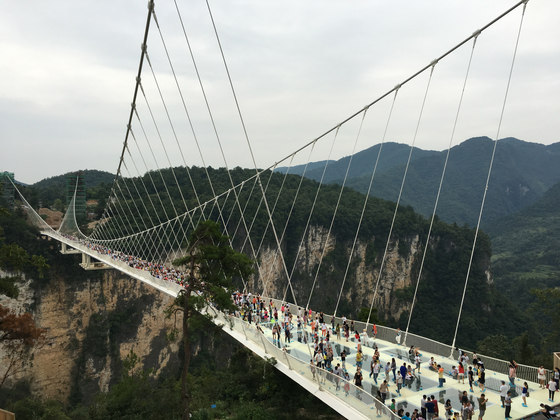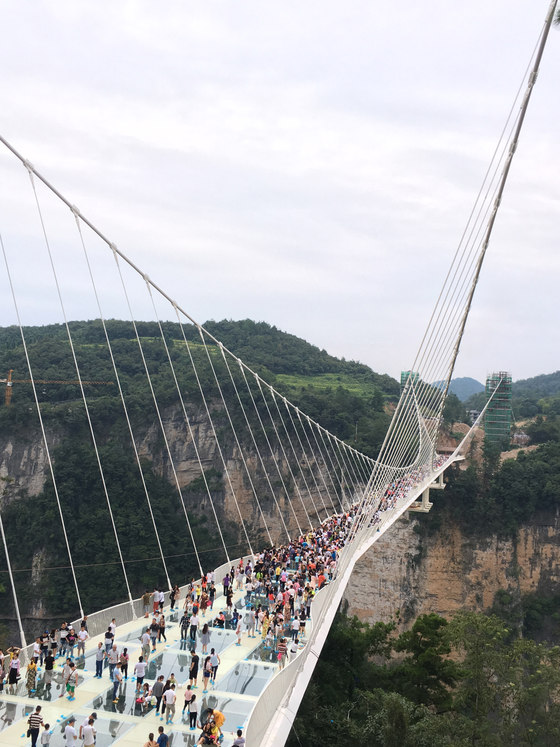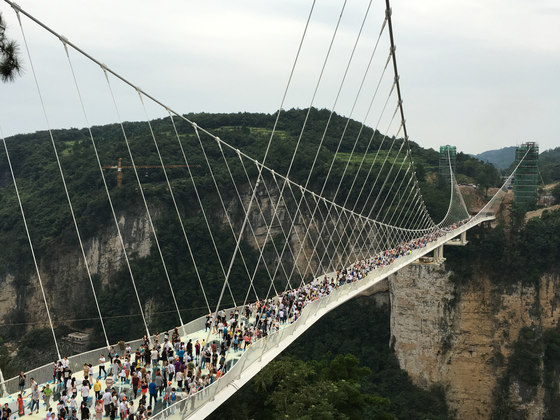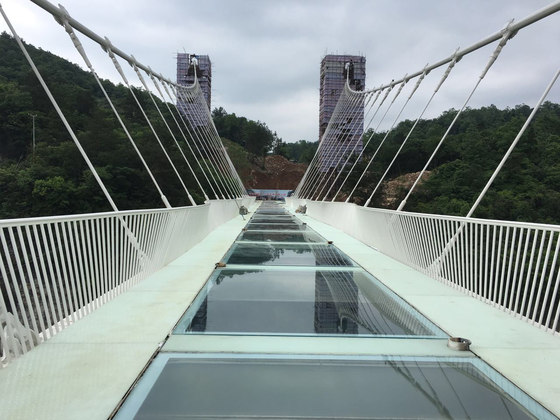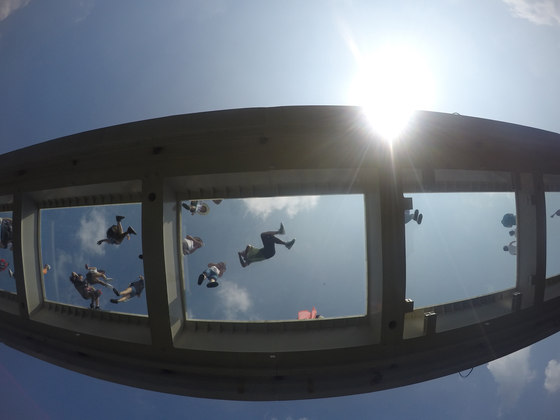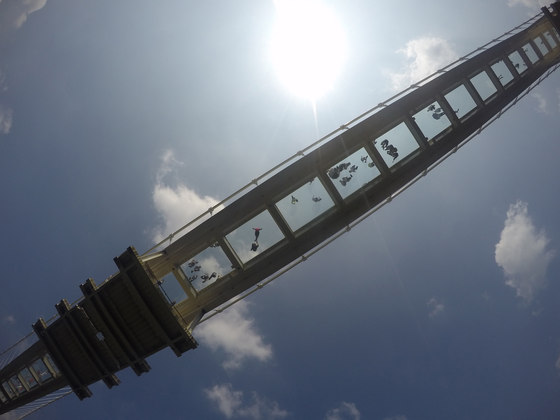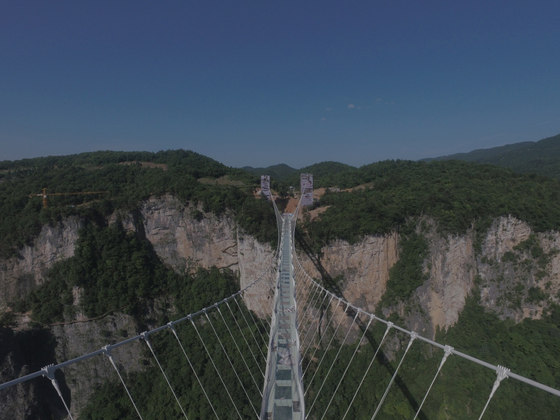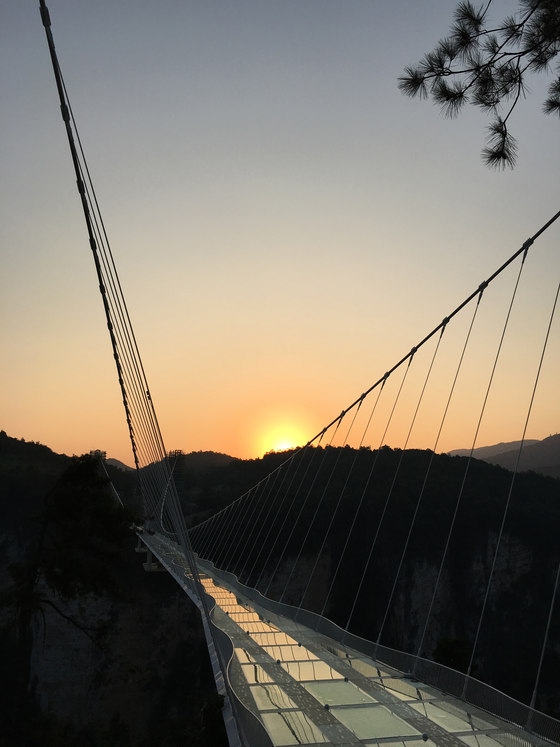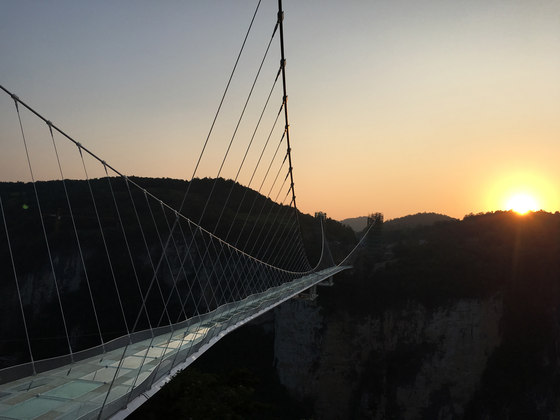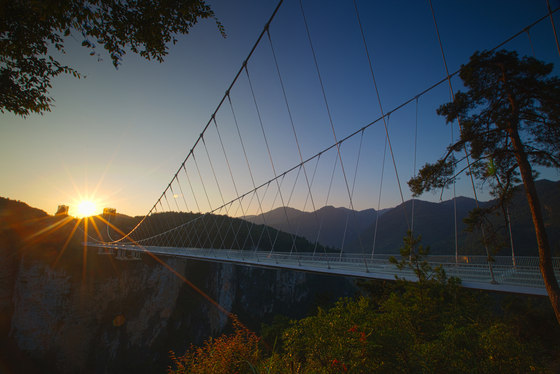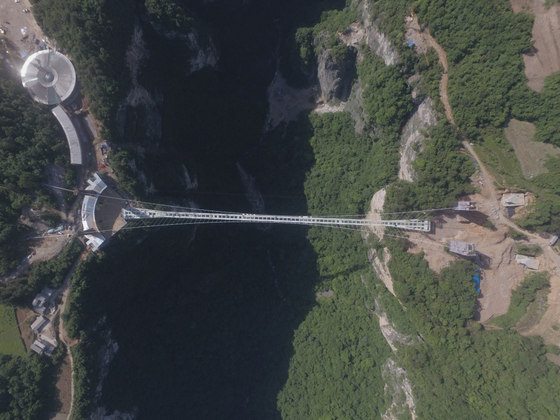Introduction of the Zhangjiajie Grand Canyon Glass Bridge
The Zhangjiajie Grand Canyon Glass Bridge is the world's tallest and longest pedestrian glass bridge in China and worldwide. Located near Zhangjiajie City in Hunan Province, People’s Republic of China, the Zhangjiajie glass bridge is 385 meters long, 6 meters wide and 300 meters above the canyon floor below. The bridge accommodates up to 800 visitors. It will feature the world’s highest bungee jump, and serve as a stage for fashion shows and cultural events.
Construction was completed in June 2016 and official opening is expected in October 2016. The Zhangjiajie Grand Canyon Glass Bridge was designed by internationally renowned architect and poet, Professor Haim Dotan, the founder of Haim Dotan Ltd. Architects and Urban Designers. The project is developed by the Zhangjiajie Grand Canyon Tourism Management Co. Ltd. The structural engineering firm is BRDI - China Railway Major Bridge Reconnaissance & Design Institute Co. Ltd.
What the Zhangjiajie Glass Bridge Means to Me?
A bridge is a place which usually takes you from point A to point B. But, the Zhangjiajie Glass Bridge is different. The bridge is an entity by itself. It is a bridge that draws people to experience its marvelous views of the surrounding serene nature. Located high above a beautiful green canyon, the bridge is a heart that brings people together. It is an event.
It is the stage for sport activities like Bungee jumping and rope sliding, and for cultural events like dancing, music and fashion shows. For me, the Zhangjiajie Glass Bridge is a dream in nature. A dream for music in the clouds, a dance in the skies between heaven and earth. I can hear out of the clouds, invisible music. It is a stage for dreams.
Design Concept: Invisible Bridge
As the designer of this bridge, located in an incredible and magical national park, I believe in nature, harmony, balance and beauty. Nature is beautiful as is. One wants to make the least impact upon it. Therefore, the Zhangjiajie Glass Bridge was designed to be invisible as possible - a thin white bridge disappearing into the clouds, into the fog.
As the ancient Chinese Tao Master, Lao Tzu, 2500 years ago said: "Great sound is unheard; Great form is invisible"
A thin horizontal bridge incorporating a transparent glass floor and side suspension cables, it creates an experience of being in pure nature while suspended in mid-air, between heaven and earth, like a butterfly with its wings open wide. Hundreds of meters above a canyon, it is without a doubt a Bridge of Wonder, a Bridge of Courage, a Bridge of Love. I called it "Bridge of Courageous Hearts" and wrote a poem: Floating in a cloud
With open heart –
I love you
Invisible Bridge: Design Methods
Out of respect for the beauty of nature, the bridge had to disappear. This was my challenge in the process of designing the bridge. We therefore put our heart, vision and love of nature, in order to create a bridge which least impacts the surrounding natural beauty. Thus we incorporated many design principles and methods to do so. We immediately conceived the glass floor in order to make the bridge transparent.
A structural girder design suspended from cables was devised to eliminate the need for bulky 3 or 4-meter bridge beams and to create a slim bridge profile with merely 60 centimeter girder beam depth, for a 400-meter span length. This is a record in Chinese engineering and bridge technology. The edges of the girder beams are trapezoid in shape, in order to open out towards the earth below, with sharp angular steel plates to break the wind on the 2 sides of the bridge.
We invented a waving handrail design to create dynamic of movement and a relationship with the spectacular views. Glass handrails were considered but rejected due to the high wind forces and high costs of the affected suspension cable system. In order to further integrate the bridge into the surrounding nature, the 4 suspension towers were covered with trees and plants, thus assimilating them into the green canyon cliffs beyond.
Bridge Engineering
General Data
• Bridge height: 300 meters
• Bungee jumping height: 280 meters
• Bridge length: 385 meters (430 meters between suspension towers)
• Bridge width: 6.0 meters
• Maximum Occupancy: 800 people at one time
• Physical Weight: 2200 tons (without cables)
Bridge Structure
The Zhangjiajie Glass Bridge is a medium-span suspension bridge. The bridge is located in a typical Karst area. Many faults and sinkholes are found surrounding the bridge’s two ends.
The canyon spans 385 meters and the towers which support the main cables stand on each side at a distance of 430 meters.
To achieve the architectural goal of integrating the bridge into nature and minimizing the height of the beams, a girder structure was designed with height of 0.6 meter and the span-height ratio reaches 625 (375/0.6), breaking the Chinese record.
Inspired by the poetic architectural design of the bridge, the chief Chinese bridge engineer described the girder in these graceful words, “as thin as a wing, and as light as a swallow, resembling a light slice floating in the sky”.
The girder is constructed of two side steel longitudinal beams and transverse cross beams. It is a composite of structural steel plate forms and concrete, with glass infills, stainless steel handrails, and with side hanging stay cables resembling “butterfly” wings.
Glass
• The bridge is composed of typical large size glass panels, 3 meters x 4 meters laminated glass.
• 50 mm thick, composed of 3 layers of 16 mm glass with 2 layers of SGP film in between.
• The glass was tested for safety under extreme heavy loads (40 tons on a 3x4 meter panel).
• The glass is Iron Free, 100% clear glass (ultra-clear glass).
• According to the deformation test, a 3 meter x 4 meter glass deforms by 2.16 cm under 20 tons.
Wind
There is a special wind effect in the canyon. The wind speed and its angle of attack are different from that on flat ground. All suspension bridges are sensitive to wind, especially when the height-span ratio reaches 625. The structure was designed to guarantee the safety and to minimize the structural response in strong wind. Hence, the bridge simulation was tested for 6 months in the Wind Testing Laboratory at Hunan University in Changsha, with wind velocity testing reaching 56 m/s, or 201.6 km per hour.
Usually, when people walk on a suspension bridge, they tend to be scared and behave differently. Thus, two tough technological difficulties, structural stiffness and human comfort, had to be carefully resolved and creatively engineered with high requirements.
Extensive engineering studies and tests were conducted: aero elasticity, wind velocities, fluttering analysis, gravitational stiffness, vibrations, dynamic analysis, and pedestrian simulations.
Special measures were devised to ensure that in the structural design for wind resistance, safety and pedestrian vibration requirements were met, with various shock absorbing technologies, and damping and anti-vibration mechanisms.
Haim Dotan Ltd.
